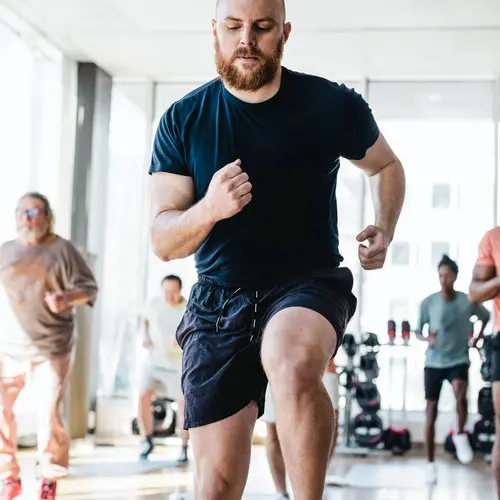How It Works
Far from the beaches of California and the big waves of Hawaii, surfing is a hot trend in fitness.
The latest surf-inspired workouts don’t require a bathing suit or breaking waves. Instead, these gym classes that are popping up nationwide use stability boards to create the same unevenness you’d find standing on a surfboard in the open water -- even if you're on dry land.
You'll do these high-intensity workouts in a group setting. They usually range from 45 minutes to an hour.
The specific movements vary, but most classes are designed to mimic the surf experience, from paddling to popping up on the board and doing a series of balance moves once you’re standing. Some classes even include yoga-inspired poses.
From paddling to lunging on the board, the surf-inspired workouts are focused on core strength and are designed to give landlubbers the same ripped bodies that surfers build while riding waves. Suntan not included.
Intensity Level: High
Forget about isolating just one area of the body at a time. Surf-inspired workouts are all about using multiple muscle groups at the same time to burn more calories during the workout.
Most surf workouts move quickly from one move to another, with lighter activity in between, a method known as interval training. You'll burn more calories and give your heart and lungs a bigger challenge than if you worked at a steady pace.
Areas It Targets
Core: Yes. Keeping yourself stable on the board requires you to constantly engage your core muscles, especially your abs.
Arms: Yes. As you push yourself up to stand on the board and paddle through the air, you will need arm and shoulder strength.
Legs: Yes. Every move you do while standing on the board will challenge your major leg muscles.
Glutes: Yes. Just like surfers riding waves, you'll be in a squat position, which engages your glutes.
Back: Yes. Surfing moves, especially holding your upper body up while you paddle, works many of the back muscles, especially the lower back.
Type
Flexibility: No. These workouts are not focused on improving flexibility.
Aerobic: Yes. Most surf-inspired classes move quickly through a series of moves to keep your heart rate up.
Strength: Yes. Balancing your own body weight engages many muscle groups, primarily in the legs and core.
Sport: No. Surfing is a sport, but surf-inspired workouts are not. They're exercise classes.
Low-Impact: No. There can be some jumping and sudden moves.
What Else You Should Know
Cost: Varies. Classes are generally taught at gyms that require membership.
Good for Beginners: No. This class is tailored for gym-goers who are looking for a fresh take on group fitness.
Outdoors: No. Most classes are taught indoors with specialized equipment.
At Home: No.
Equipment required: Yes. There are a variety of balance trainers for surf workouts.
What Dr. Melinda Ratini Says:
Surfing workouts are a great way to get in your cardio and strength building all at once. You'll be using your core the whole time. Your instructor can add moves to build your arm and leg muscles.
But the fact that you are doing all this on a moving surface really raises your chances of getting injured.
If you are very athletic already and looking for something different or just wanting to keep in shape for catching real waves in the summer, then surfing workouts are for you. But these high-intensity workouts are not meant for beginners or weekend warriors.
If you have achy joints or are pregnant, opt for swimming rather than surfing.
These workouts are also not for you if you'd rather go it alone. Surfing workouts are done in a group setting in a gym with special equipment and trained instructors.
Is It Good for Me if I Have a Health Condition?
Surfing workouts are sure to give you a high-intensity workout to help drop extra pounds and get stronger.
If you have prediabetes, these are the things that could help prevent it from turning into diabetes. If you already have diabetes, ask your doctor first. If you're already doing challenging workouts, your doctor may OK surfing for you; but it is not the activity for you if you're just starting to exercise.
Complications such as diabetes-related nerve damage will put you at greater risk for injury and for falling. You should also avoid high-intensity workouts, such as surfing, if you have a diabetes-related eye problem called diabetic retinopathy. A more moderate-intensity, lower-impact workout would be a much safer fit.
Surfing can also help you reach your fitness goals if you have conditions like high blood pressure and high cholesterol that put you at risk for heart disease. But you should check with your doctor first.
With its high-impact and balance-challenging moves, surfing is not for you if you have arthritis or back, hip, knee, or ankle problems. Sudden moves are much more likely to cause injury than a sustained aerobic workout such as swimming, biking, or walking.
Surfing is also not a good fitness choice if you are pregnant. As your belly grows, your center of gravity will be thrown off. Your joints also become more lax. These things put you at risk for foot and ankle injuries and for falls.
If you have heart disease, talk to your doctor before considering a new fitness program. Surfing is definitely not something you should attempt if you are out of shape or had a recent heart attack. Your doctor may recommend enrolling in a cardiac rehab program. There, your heart’s response to exercise can be monitored as you gradually become more active.


